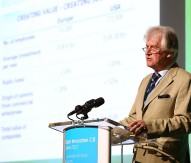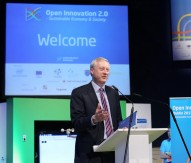
Kicking into innovative action
Alexander von Gabain has been a member of the Governing Board of the European Institute of Innovation and Technology (EIT) since its inception, rising to the post of chair in September 2011. On the sidelines of last month’s ‘Open Innovation 2.0’ at Dublin Castle in the Irish capital, von Gabain spoke to Pan European Networks about developing the EIT as a true ‘innovation impact investor’ and creating several new Knowledge and Innovation Community (KICs), the operational aspect of the Institute.
What are the future plans of the KICs and how will the extra Horizon 2020 funding be invested?
The increase in budget is yet to be firmly agreed – it’s up to the European Parliament to give the final go ahead, although I anticipate a marked increase. We will be wisely investing the money in developing the existing KICs (Climate-KIC, EIT ICT Labs and KIC InnoEnergy) but also implement another two waves of KICs. I see the EIT as a high-impact innovation investment fund and while you may think it is easy to step-up from three to six to nine KICs in total, I don’t think we can just extrapolate the system in this fashion. The challenge is how to make the organisation fit. We need strategic considerations and decisions, e.g. how we distribute the money to the KICs and how do we award the new ones. We have invested €300m in the first five years and this should rise to €2-3bn in the future.
We need structures in place like a good venture capitalist, not only providing the money, but also the networks and the connections and again we need to learn from the experience of the three existing KICs in order to give this knowledge back to Europe. We also hope to inspire European countries, bilateral or even multilateral, to build similar KIC-like structures.
Why do you think it has taken so long to develop KICs in Europe?
It took the EU’s political bodies a very long time to agree what we were proposing for the EIT; this was outside of our control. Yet once the board members had been selected, I think we have an incredible track record and quickly established the first three KICs. In September 2008, we created the first KIC, which was enormous work because there was no EIT headquarters or KIC board members. We had consortia of industry, universities and business schools that all had different expectations of research support and funding grants.
Within Horizon 2020, I would like to see the EIT as a game changer, and that it’s not enough to encourage collaboration between a couple of corporations, SMEs and universities. I don’t think any organisation in Europe has taken the ownership, accountability or the vision in what we are doing. The EIT is tying all the key players together within Horizon 2020 – we are the interconnectivity player.
The KICs focus on bringing together universities, industry and the public bodies. What role does the citizen play in the Knowledge and Innovation Communities?
That’s a very good point, which I guess is one of the next challenges of the KICs as well as EIT. We have to be smart with the KICs and involve the citizen. We are already doing this, to an extent, at our regional co-location centres where we are trying to get out into communities. One of our proposed KICs, ‘Innovation for healthy living and active ageing’ will involve and affect citizens considerably. It’s not only classical innovation; it’s also about social innovation.
What action has the EIT taken to encourage to further ‘innovator initiators’ in Europe?
I feel the EIT has done two things: it has implemented the KICs in a relatively short period of time, but it has also kicked-off discussions on Horizon 2020 within EU member states, demonstrating that innovation is much more than top-class research – good education and close co-operation is also key and this is something we need to continue.
We have a total lack of venture capital in Europe, which is a disaster. Only now we see the KICs growing and the EIT concept becoming accepted, that we can go back to Europe’s politicians and encourage them to bet on their children’s future money. In the US, whilst the elder generation invests 3-6% of their assets annually in new innovative companies whereas in Europe, it is 50 cents per €100 earned. It is not only because people are not willing to do this for the next generation, there is also a problem with tax legislation in many European member states, which is so disastrous towards venture capital. Once we have established the KICs, we have to seek new opportunities on how to develop the infrastructure so we can create a more entrepreneurial environment, which will help to foster more entrepreneurial companies.
How is EIT looking to promote international research collaboration and help create a global innovation ecosystem?
I think one Europe’s weakness when looking at United States is that we unify the country too much. Boston, Silicon Valley and Washington, DC have some of the best KICs in the world and we are playing a kind of catch-up race. Yet if you go to St Louis in Missouri, home to Washington University, knowledge and research still operate in silos and the EIT’s KICs could become a paradigm in the local area when setting up similar types of initiatives.
Alexander von Gabain




